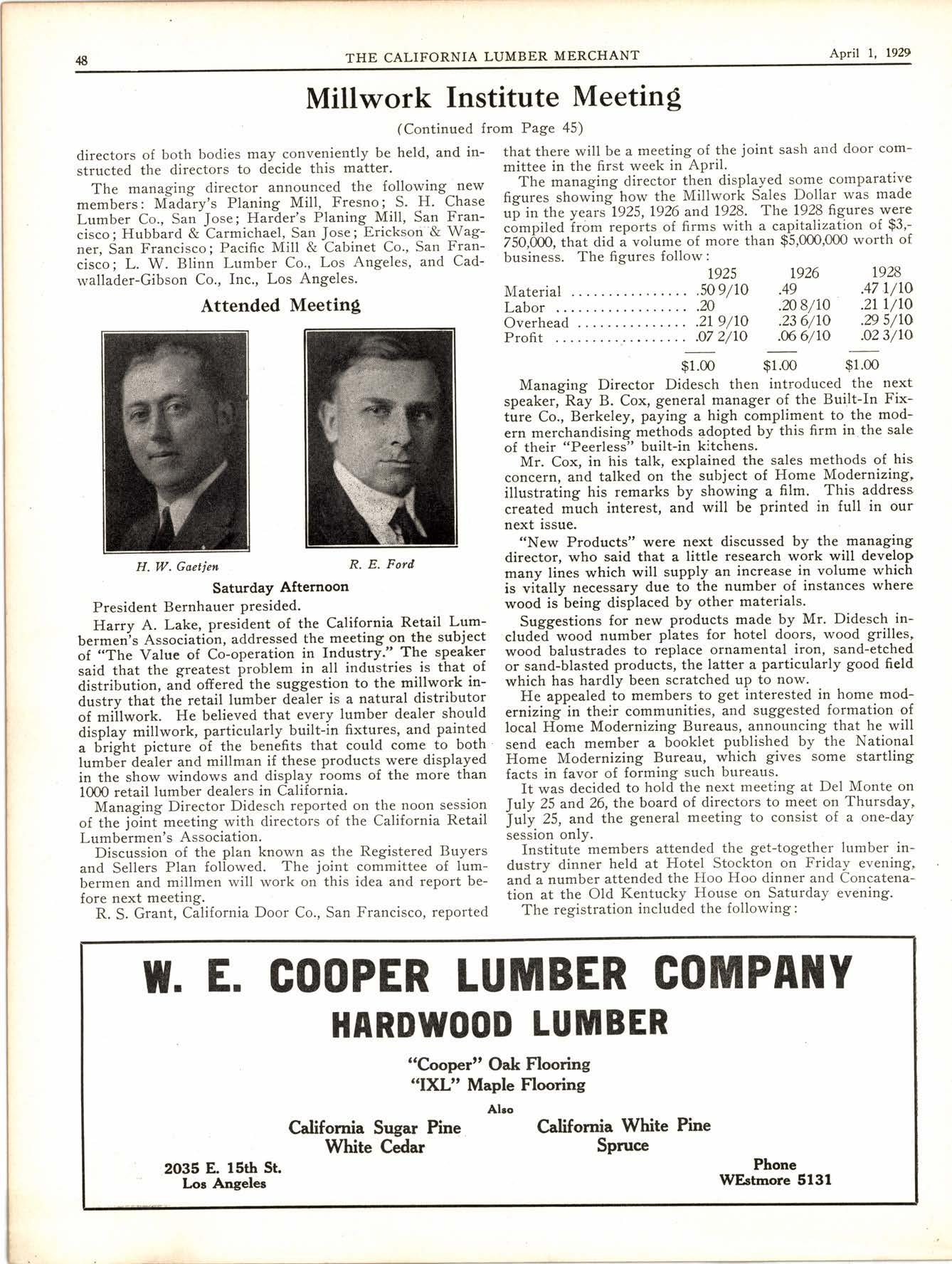
3 minute read
Random Editorial Ramblings
By Jack Dionne
The other day at a lumber manufacturers convention, a nationally known mill man said to me: "I read in your paper about the Blank Lumber Company's new steel and concrete sawmill. I don't think you ought to high light that sort of news. That's what's the trouble with the lumber business." "Yes,t' I said, 'I think yorr.'re dead right about it. That IS the trouble with the lumber business. That, of course, and a few other things. One of the other things, of coursg is the fact that when most of you prosperous mill men build, you never use any lumber if you can help it. Now, if I'm not mistaken, YOUR house is built of brick and stone. There's tile on your roof. The porches are of concrete and stone and metal. A lot of the foors in your house are
But my voice no Ionger reached him. He was fifty feet down the lobby of the hotel, and travelling fast. 'Whenever you go looking for someone to tell you what is the matter with the lumber business-see me.
The whole state of California-speaking of lumber of coursHw€s a definite and particular debt of gratitude to Kenneth Smith, of Los Angeles, for his work of the last year in ttre Los Angeles district. It goes without sayrng that there can be no general or abiding prosperity in thd lumber industry of California so long as the Los Angeles district, with its more than two million inhabitants and its lumber consumption larger than that of the huge city of New York-is not prosperous. And lumber things were troubled and disturbed in the Los Angeles district for a string of years, profits were almost unheard of and chaos was the general order of things. It affected every corner of California, naturally. Kenneth Smith and his organization have brought order out of chaos, and things look hopeful, very hopeful indeed, in this great lumber center.
Ilfore 1rcwer to him! * !& *
I would like to give the cement manufacturers of California a piece of unsolicited advice. START ADVERTISING. Carry the story of cement to the people of California. Advertise your individual wares, and advertise collectively your cement and concrete story. The most unintellige,nt thing about your methods of doing business in the past, has been your stern determination NOT to advertise. I think your present clash with the Legislature is blameable very directly to your continual silence on the subject of your own business. f have noticed-and I have watched this thing for a great many years and watched it closely-that in other territories where Cemqrt has been attacked, it has been in the non-advertising districts. And'I have noticed that in the territories where the various cement companies are enthusiastically carrying thEir stories to the public, they have no troubles of that sort. Believe it or not, it's a dernonstrable fact.
Turn the searchlight of publicity on your business ! Show the public that you are proud of it, that you want to talk about it, that there is nothing to be hidden about it, as your general disposition to covetr it with a cloud of silence might cause people to suspect. Remember this! It's the birds that fy in darkness that people are afraid and suspicious of, and take shots at-not those that sing in the sunlight on their front porch ! :1.**
One or two ceanent manufacturers in California are enthusiastic advertisers. But taken as a whole the industry in California has deliberately and cooperatively covered itself with a cloak of silence, and thought it was doing something wise. The fact is that in this day and generation no more dangerous method of business procedure could be discovered. What I'm writing here I've told individuals in the cement industry various times in years gone by. Any industry of that sort which decides.not to advertise is simply laying up trouble for itself. They ultimately run headlong into the very thing they have been trying to avoid. Vocalize your business. Print it broadcast. Shout it from the housetops. Sing the praises of your individual brands and wares. Register your industry and its individual units stoutly on the mentalities of the population; and when you do you will be doing more to keep out of trouble than hiring a hundred lawyers.
Every day the possibilities of plywood grow broader. The other day I went through a big fixture factory with its owner. He told me the biggest improvemetrt that has come to his business in ten years has been through the newly adopted use of plywood. He used to use a certain hardwood fo'r the backs, bottoms, and shelves of his garment cabinets-a large part of his business. Thc wood had to be dried after he got it, glued up on edge, dressed, etc. One day he tried a sample of plywood. Now he buys it in several car lots. Just saws out of plywood the sizes he wants, no drying, no dressing, no gluing, no extra handling, just big fine clear boards ready to fit in single piece units his e\rery want. That man is the biggest plywood enthusiast I have met.
The writer is something of an Association believer and enthusiast himself, but he saw a boost for association work the other day that was a hummer. The Secretary of a certain retail lumber association was giving the various uses of his association, and the ver5r first thing he listed as an activity of his organization was "To combat the growing chain-store competition." Fine! And with most of the retail lumber yards in the country in "chains" themselves, and getting more and more that way with
(Continued on Page 8.)









